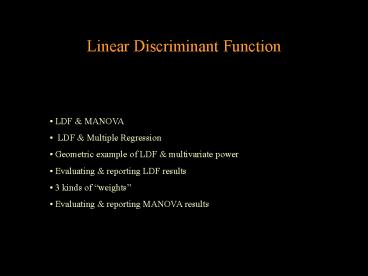Linear Discriminant Function - PowerPoint PPT Presentation
Title:
Linear Discriminant Function
Description:
Linear Discriminant Function. LDF & MANOVA. LDF & Multiple Regression ... linear discriminant function -- a linear function of the original variables ... – PowerPoint PPT presentation
Number of Views:62
Avg rating:3.0/5.0
Title: Linear Discriminant Function
1
Linear Discriminant Function
- LDF MANOVA
- LDF Multiple Regression
- Geometric example of LDF multivariate power
- Evaluating reporting LDF results
- 3 kinds of weights
- Evaluating reporting MANOVA results
2
- ldf MANOVA
- 1 grouping variable and multiple others
(quantitative or binary) - Naming conventions
- LDF -- if the groups are naturally occurring
- bio-taxonomy to diagnostic categories
measurement - grouping variable is called the criterion
- others called the discriminator or predictor
variables - MANOVA -- if the groups are the result of IV
manipulation - multivariate assessment of agricultural
programs - grouping variable is called the IV
- others called the DVs
3
- Ways of thinking about the new variable in
ldf/MANOVA - (like regression) involves constructing a new
quantitative variate from a weighted
combination of quantitative, binary, or coded
predictors, discriminators or DVs - The new variable is constructed so that when
it is used as the DV in an ANOVA, the F-value
will be as large as possible (simultaneously
maximizing between groups variation and
minimizing within-groups variation) - the new variable is called
- linear discriminant function -- a linear
function of the original variables constructed
to maximally discriminate among the groups - MANOVA variate -- a variate is constructed
from variables - canonical variate -- alludes to canonical
correlation as the general model within which
all corr and ANOVA models fit
4
How ldf MANOVA work -- two groups and 2 vars
Var 2
Var 1
Plot each participants position in this
2-space, keeping track of group membership.
Mark each groups centroid
5
Look at the group difference on each variable,
separately.
Var 2
Var 1
The dash/dot lines show the mean difference on
each variable -- which are small relative to
within-group differences, so small Fs
6
The ldf or MANOVA/Canonidal variate positioned
to maximize F
Var 2
Var 1
In this way, two non-discriminating variables can
combine to work
7
- Completing Reporting the results of a
2-group ldf Analysis - 1. Does the model work ?
- basic summary statistic is ? (Wilks lamba) --
smaller is better - transformed into X² to test H0 of sphericity
- 2. How well does the model work ?
- ? can be interpreted, with practice
- Rc canonical correlation -- like R from
multiple regression - Rc² is between group variance accounted for by
ldf - pct of variance -- tells of between group
variance (100) - correct reclassification -- results from
applying model to assign participants to groups
8
- 3. Interpreting the ldf
- Three possible bases for interpretation
- unstandardized or raw discriminant weights
- just like multiple regression weights (but no
signif tests) - of limited utility because of scale effects on b
- standardized discriminant weights
- just like multiple regression ? weights
- useful for unique contribution interpretation
- discriminant structure weights
- correlations between ldf and each variable
- useful for descriptive interpretation
- The best (most complete) interpretation will
result by combining the information from the
standardized and structure weights !!
9
- Comparing the bivariate and multivariate group
differences - As with multiple regression, we can have various
suppressor effects, such that variables
contribute to the ldf differently than their
bivariate relationship with group membership - 5. Determining what the ldf does for us --
discrimination - Consider the group centroids (means) on the ldf
- big difference? - Centroids will be symmetrical around zero with 2
n grps - Consider the re-classification results
- an over-estimate of models discriminating power
(uses the same participants upon which the model
was built) - compare models performance to baserate or
chance - look for asymmetry -- sometimes one group is
easier to identify than the other - might employ cross-validation or a hold-out
sample to improve the utility of the assessment
10
- Completing Reporting the results of a
2-group MANOVA - 1. Does the model work ?
- basic summary statistic is ? (Wilks lamba) --
smaller is better - transformed into F to test multivariate H0
- 2. How well does the model work ?
- Rc canonical correlation -- like R from
multiple regression - 3. Comparing the bivariate and multivariate group
differences - As with multiple regression, we can have various
suppressor effects, such that both multivariate
power null washout effects can occur.
11
GLM vs.MANOVA getting the weights Show both for
one data set































